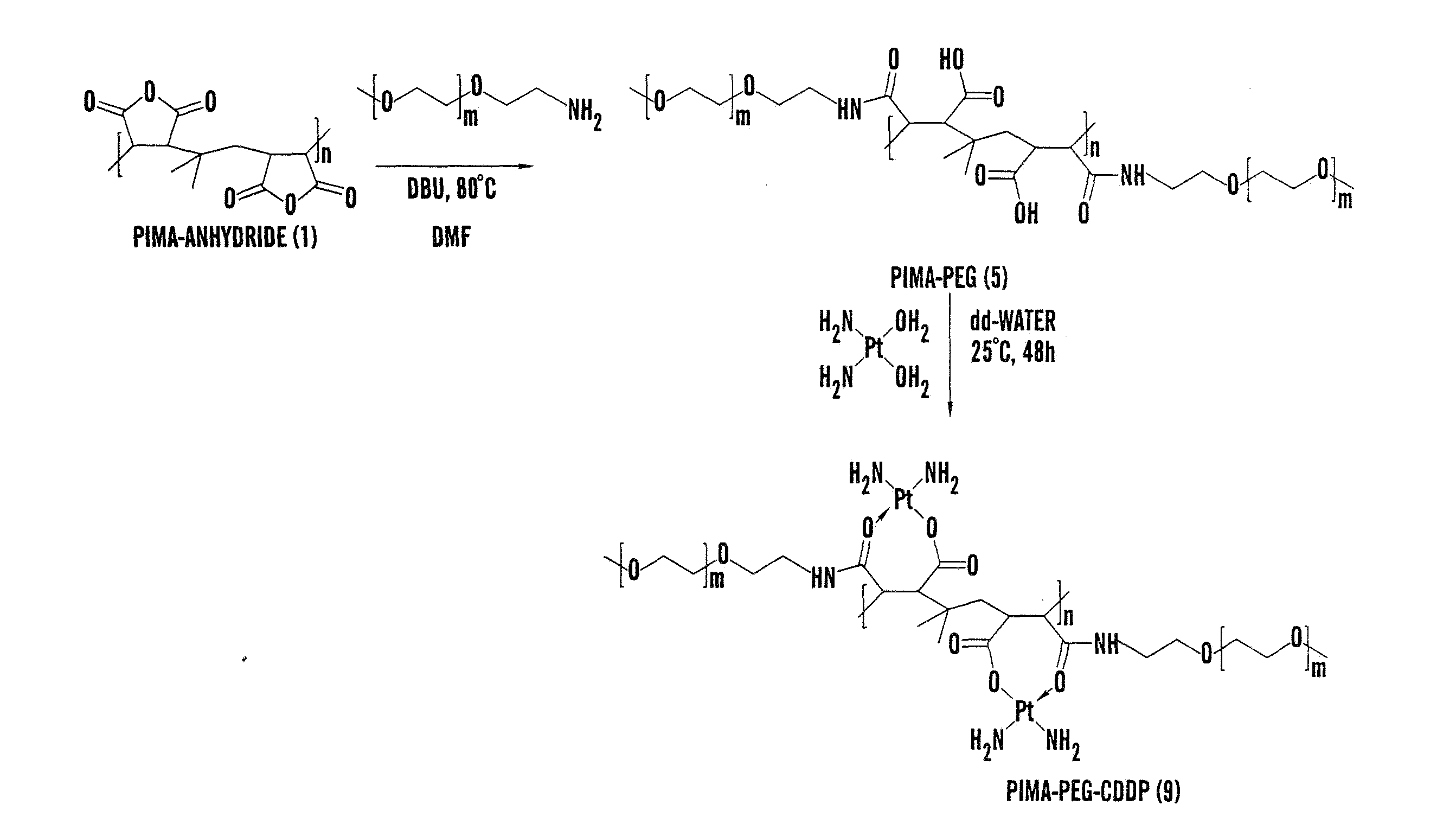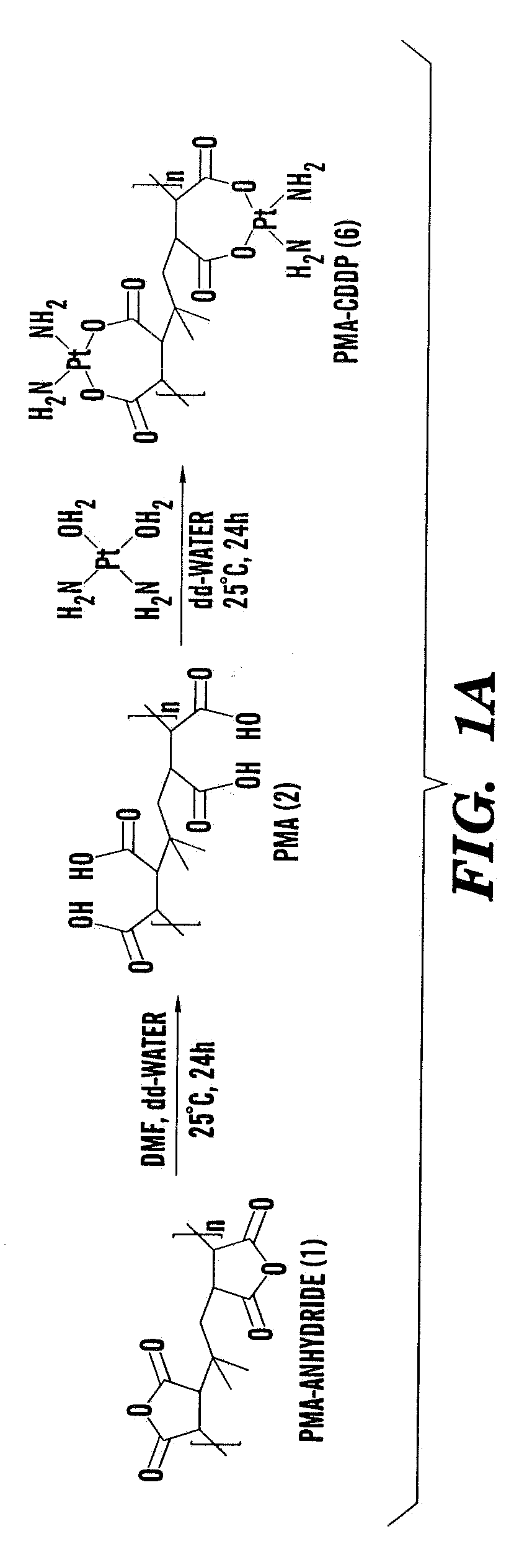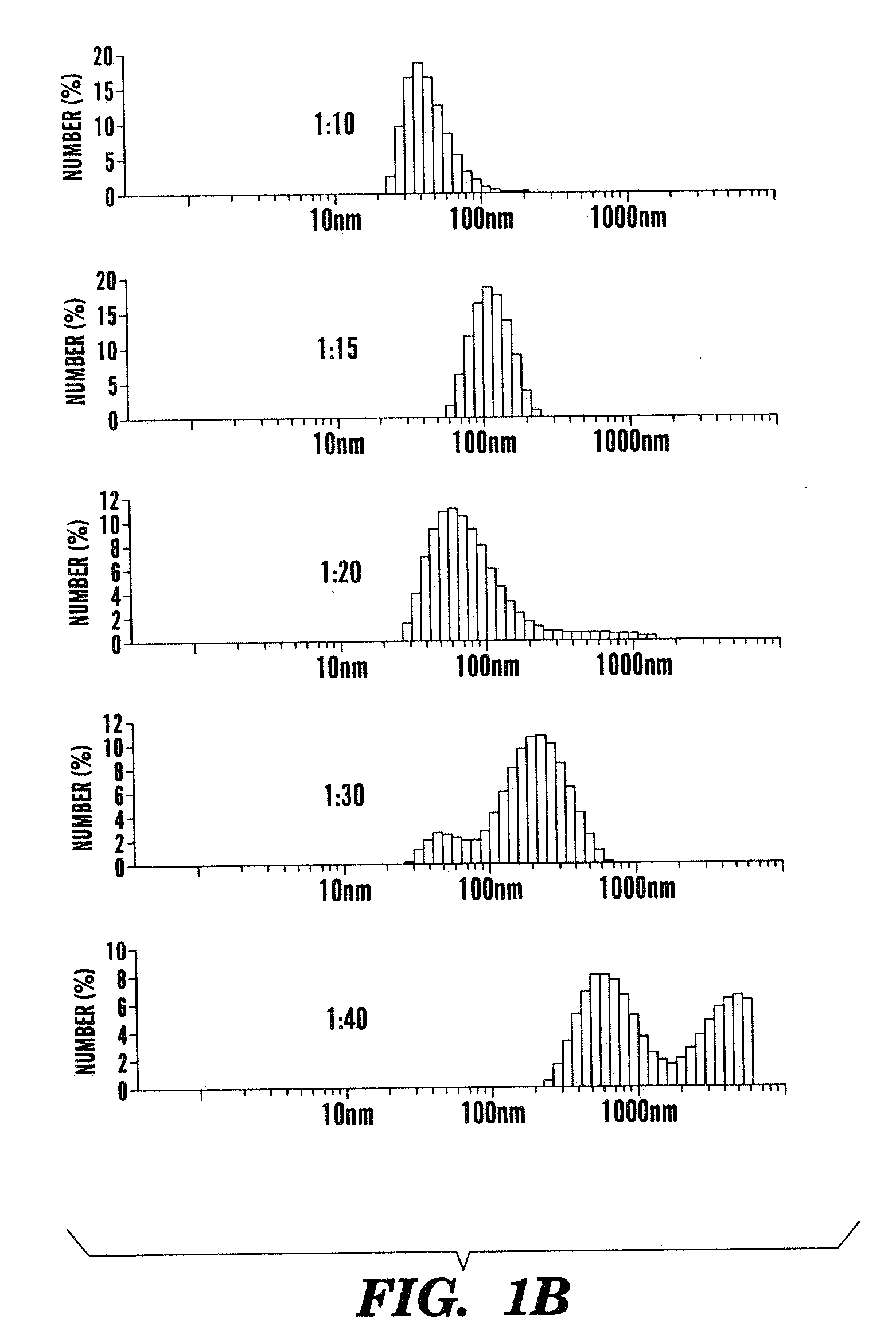Nanoscale platinum compounds and methods of use thereof
a platinum compound and nanoscale technology, applied in the field of biocompatible conjugated polymer nanoparticles, can solve the problems of limited use, reduced potency of conjugated active agents, and toxicities that limit the dose, so as to reduce systemic and nephrotoxicity, reduce the effect of toxicity, and stain the potency of active agents
- Summary
- Abstract
- Description
- Claims
- Application Information
AI Technical Summary
Benefits of technology
Problems solved by technology
Method used
Image
Examples
example 1
Synthesis of Polymeric Carriers
[0279]Polyisobutylene-alt-maleic acid) PIMA (2)
[0280]Poly(isobutylene-alt-maleic anhydride) 1 (1 g) was dissolved in 5 ml of dry DMF in 10 mL round bottom flask to which was added double distilled water (1 mL) and then resulting reaction mixture was stirred at 80° C. for 48 h. Solvent was removed under vacuum and low molecular weight impurities were removed using dialysis. Aqueous polymer solution was dialyzed for 3 days in cellulose membrane tubing, types Spectra / Por 4 and with mass-average molecular mass cut-off limits of 1000. The colorless solution was then lyophilized to get 732 mg of white colored polymer Poly(isobutylene-alt-maleic acid) PIMA (2). 1H NMR (300 MHz, D2O) δ 3.3-3.5 (m), 2.8 (s), 2.6-2.7 (m), 2.5 (s), 2.2-2.3 (m), 0.8-0.9 (m).
PIMA-EDA (3)
[0281]The 10 mL RB flask equipped with magnetic stirrer and dry nitrogen balloon was charged with Poly(isobutylene-alt-maleic anhydride) PIMA 1 (1 g), dry DMF (5 mL), Triethyl amine (0.1 mL) and exc...
example 2
Synthesis of Conjugates
Aquation of CDDP
[0285]CDDP (30 mg) and AgNO3 (17 mg) was added to 10 ml double distilled water. The resulting solution was stirred in dark at room temperature for 24 h. AgCl precipitates were found after reaction. AgCl precipitates are removed from reaction by centrifugation at 10000 rpm for 10 min. The supernatant was further purified by passing through 0.2 μm filter.
PIMA-CDDP (6)
[0286]Poly(isobutylene-alt-maleic acid) PIMA 2 (0.006 g, 0.001 mmol) was dissolved in 1 ml double distilled water containing CDDP (0.00084 g, 0.0028 mmol) in 10 mL round bottom flask to and then resulting reaction mixture was stirred at room temperature (25° C.) for 48 h. The PIMA-CDDP (6) conjugate was further purified by dialyzing it in cellulose membrane tubing, types Spectra / Por 4 and with mass-average molecular mass cut-off limits of 1000. The resulting turbid solution was then lyophilized to get white colored PIMA-CDDP (6) conjugate. The conjugate was re-suspended for cell cult...
example 3
NMR Analysis of PIMA-GA Polymer Synthesis Using Different Bases
Synthesis of PIMA-GA Using DBU as the Base
[0293]Glucosamine hydrochloride (360 mg, 1.66 mmol, 200 equiv) was suspended in 5 mL DMF and treated with DBU (250 μL, 1.66 mmol, 200 equiv) at room temperature for 1 h. After 1 h glucosamine / DBU (in DMF) solution was added drop wise into poly (isobutylene-alt-maleic anhydride) (50 mg, 0.008 mmol, 1 equiv) solution in 5 mL DMF and the reaction mixture was stirred for 72 h at room temperature. The reaction mixture was quenched with 3 mL of dd-water. The PIMA-GA conjugate was purified by dialysis using 2000 MWCO dialysis bag for 72 h. The product was lyophilized for 48 h to obtain 100 mg cream yellow powder. The product was characterized by 1H NMR spectroscopy (300 MHz). Solubility: product was soluble in water but not soluble in organic solvent e.g. acetone, methanol or acetonitrile. 1H NMR (300 MHz): δ (ppm)=5.2-5.3 (m, 0.14H, sugar proton), 5.0-5.1 (m, 0.4H, sugar proton), 3.6-4...
PUM
| Property | Measurement | Unit |
|---|---|---|
| molecular weight | aaaaa | aaaaa |
| molecular weight | aaaaa | aaaaa |
| molecular weight | aaaaa | aaaaa |
Abstract
Description
Claims
Application Information
 Login to View More
Login to View More - R&D
- Intellectual Property
- Life Sciences
- Materials
- Tech Scout
- Unparalleled Data Quality
- Higher Quality Content
- 60% Fewer Hallucinations
Browse by: Latest US Patents, China's latest patents, Technical Efficacy Thesaurus, Application Domain, Technology Topic, Popular Technical Reports.
© 2025 PatSnap. All rights reserved.Legal|Privacy policy|Modern Slavery Act Transparency Statement|Sitemap|About US| Contact US: help@patsnap.com



